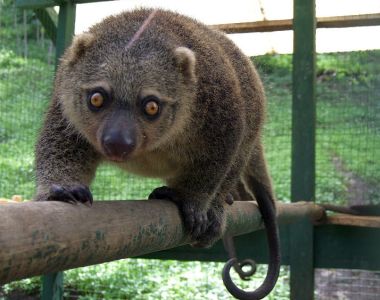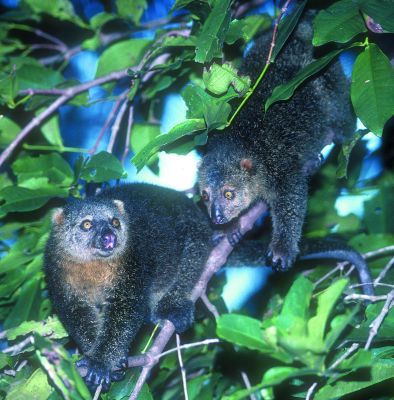The Sulawesi bear cuscus

What has eyes like a lemur, a furry body like a koala, a head like a possum, is often called a ‘marsupial monkey’, and shares its island home with pigs, primates and dwarf buffaloes?
The answer is the Sulawesi bear cuscus.
This unusual marsupial has many characteristics of a possum, but is closer in size to a tree kangaroo. It has round, yellow-rimmed eyes, a box-like snout, long limbs and large feet.
It also has a prehensile (grasping) tail, which it uses as a fifth limb to navigate its way easily through the tree canopy. The tail coils around a branch like an anchor while the front limbs secure a hold. The back limbs dangle free at first, then slowly swing forward to grasp another branch. Bear cuscuses travel with such grace that they are sometimes referred to as the ‘slow-motion acrobats of the forest’.1
The Phalanger genus is made up of seven species of cuscus which range from Indonesia to northern Australia. However, the Sulawesi bear cuscus is only found on the Indonesian island of Sulawesi and its satellites.
A recent article in Nature Australia magazine2 described the geographical distribution of the bear cuscus—‘an essentially Australian type of marsupial’—as strange. This is because Sulawesi is considered to be a part of Asia, where marsupials are generally not found. On Sulawesi, the bear cuscus shares the tree canopy with typically Asian mammals such as tarsiers and macaques (both primates), and squirrels.3
However, it should always be remembered that beliefs about where animals ‘should’ be found are tempered by many evolutionary presuppositions. We find animals today wherever they have arrived/survived following many centuries of migration/dispersion (initially from Ararat in the case of land vertebrates) after the Genesis Flood. Thus, there may be large-scale ‘patterns’, since many species have not arrived separately from each other, but are the result of ‘splitting’ from one ancestral kind (e.g. different varieties of bear arising from one type, always with a loss of information, thus no ‘evolution’ in the microbes-to-man sense).4 But there will ultimately be no ‘forbidden’ or ‘impossible’ distributions.
The island of Sulawesi is home to two species of cuscus: the bear cuscus (Phalanger ursinus5) and the dwarf cuscus (Phalanger sangirensis6). They represent the largest and smallest of the cuscuses, with bodies ranging from 30 to 65 cm (12 to 25 in) and tails from 25 to 60 cm (10 to 24 in).7
Most cuscuses behave like traditional marsupials in that they are more active in the night than the day. The bear cuscus, however, is reported to be the opposite. Unlike the other cuscuses, which have cat-like slit pupils, the bear cuscus has a round pupil that may not see as well in the dark.3
Experts agree that little is known about the Sulawesi bear cuscus because of its elusiveness. What is known is that it spends most of its life in the trees, eats leaves and occasionally fruit, and is often found in pairs.

Some experts believe, based on its size and those ‘daylight’ pupils, that the bear cuscus is an ancient survivor from an earlier lineage of ancestral possums.3 Its location on Sulawesi also raises a number of questions. It is one of the few Australasian-type marsupials to be found in the Northern hemisphere, and shares its home with a broad mix of animals, including two species of pig, two species of dwarf buffalo, and several species of squirrel.8
A commonly held opinion is that the bear cuscus rafted to Sulawesi on a mat of vegetation (evolutionary estimates of time range from 11,000 years ago1 to 30 million years ago3). There, it survived while those remaining behind on Greater Australia became extinct. In the evolutionist’s framework, its cousin, the dwarf cuscus, must therefore also have done the same, but it must have done so much later, as it is considered to be more ‘modern’ than the bear cuscus.1
Note how this not only highlights the role of presuppositions, but can be used to help answer a common objection many people raise concerning how animals could have crossed deep water to get to remote places after the Flood. To solve their own conundrums, evolutionists are willing to concede that animals could have travelled by natural rafts, unaided by humans. So why cannot a creationist utilize the same explanation for some cases?
There is no indication that either the bear cuscus or dwarf cuscus, which are today found together, is a more advanced version of a cuscus than the other. In fact, they may have descended from the same created kind, just as wolves, coyotes and dingoes are almost certainly descended from a ‘dog/wolf’ kind. The cuscus’s ancestors may have arrived on Sulawesi and have diverged since, or they may be the result of two separate migration/dispersion events. The evolutionists’ ‘rafting’ explanation might in fact be correct for one or both of these animals.
Natural selection can explain many of the observed features of animals demonstrating a ‘fine-tuned’ adaptation to where they currently live. The ‘key’ to remember is that natural selection only chooses from things, it does not create them. The information has to be there from which it can choose.9 Evolutionists often ‘muddy the waters’ by making it sound as if natural selection and evolution are one and the same thing, which we have repeatedly shown is not the case.10
Notice how evolutionists and creationists often believe the same things—natural selection, rafting to island homes and so on—the difference is generally that evolutionists slow things down, adding in the time factor. However, rafting does not take long time periods, nor does migration by dispersion (modern ‘invasions’ of colonizing animals have shown this repeatedly).
Neither does adaptation by natural selection (given a large created store of genetic information from which nature can ‘choose’), even to the extent of forming ‘new’ species, take long, as real-world data has shown repeatedly.11
We need to understand that the creation/evolution issue is not only about whether or not, or how, God created. It is also about a clearcut history of the Earth given in the Bible. If we take God’s Word as written, then we can make sense of the evidence of the world around us. Animals were not created in Sulawesi, or in Australia, for that matter. They migrated there after a globe-destroying catastrophic event (from which such places emerged), a Flood which was ultimately about judgment on sin. We can see from all this how issues such as sin and morality cannot be artificially separated from things like geology, biology—and animal distribution.
It is also clear that creationists and evolutionists use the same science, basically. The difference is the history into which the science is put.
Remember that the next time you hear someone say the Bible is ‘not a science textbook’—as if that means a believer can just ignore areas of conflict between the Bible and evolutionary conclusions. No, it’s not a science text, but it does make clear truth-claims about the history of the world and mankind. The point is that you can’t build true science on a false history of the Earth. Which is all you can end up with if you reject/neglect the true history in the Creator’s Word to mankind.
Re-posted on homepage: 20 September 2023
References and notes
- Cuscus, www.geocities.com/TheTropics/Paradise/5301/Pg000016.htm, 11 February 2002. Return to text.
- Nature Australia, 26(12):24–31, Autumn 2001. Return to text.
- Ref. 2, p. 26. Return to text.
- Weston, P., Wieland, C., Bears across the world … , Creation 20(4):28–31, 1998. Return to text.
- A.k.a. Ailurops ursinus. Return to text.
- A.k.a. Strigocuscus celebensis. The differing alternate genus names for the two reflects some of the confusion and uncertainty surrounding the alleged evolutionary relationships. Return to text.
- The New Encyclopaedia Britannica, 15th Edition, 3:808, 1992. Return to text.
- Ref. 2, p. 27. Return to text.
- Mutation (genetic error) has not been demonstrated to provide that information source; even in the rare instance where a genetic defect gives a survival advantage, it is still a loss of information. See Wieland, C., Beetle bloopers, Creation 19(3):30, 1997. Return to text.
- Wieland, C., Muddy waters, Creation 23(3):26–29, 2001; The evolution train’s a-comin’, Creation 24(2):16–19, 2002. Return to text.
- Catchpoole, D., Wieland, C., Speedy species surprise, Creation 23(2):13–15, 2001. Return to text.











Readers’ comments
Comments are automatically closed 14 days after publication.